Tiny Black Bugs That Look Like Poppy Seeds (With Pictures) – Identification Guide
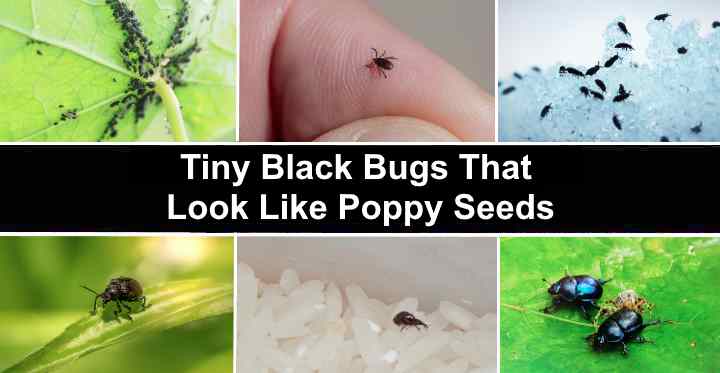
Tiny black bugs resembling poppy seeds are annoying pests that can invade indoor spaces. The tiny black insects, mites, and bugs can infest foodstuffs, furniture, houseplants, and pantries. These minuscule creatures are not just pesky unwanted visitors. Some small black bugs can cause a nasty bite and spread disease.
Identifying tiny black bugs that are about the size of poppy seeds can be challenging. In most cases, their tiny size means it is almost impossible to spot a single bug independently. And if you spot a cluster of black poppy seed-sized bugs, you must deal with a large infestation.
Getting rid of black bugs that look like tiny dark specks can be difficult. Typically vacuuming the pesky, nano-sized pests is the most effective eradication method.
Additionally, thoroughly cleaning areas of your home where tiny dark-colored bugs can be lurking is crucial. This process helps kill eggs to prevent further infestations and disinfect surfaces from potential bacterial spread.
This article helps you recognize the identifying features of tiny black bugs that resemble poppy seeds. Descriptions and pictures of these small insects will help determine if you have an infestation problem. You will also get tips on how to get rid of minuscule black bugs.
What Are Tiny Black Bugs?
Tiny black bugs refer to small, dark brown or black creatures ranging in size from a pinhead to the size of a poppy seed. Some examples of small black bugs include fleas, ticks, black ants, bed bugs, and aphids.
In scientific terms, small black bugs belong to the insect order Hemiptera. These creatures have piercing mouthparts to bite plant tissue or human or animal skin. However, most people refer to all small annoying black insects as bugs, even though they are not bugs in the true sense of the word.
This article will refer to all types of black insects as bugs, regardless of whether they are true.
How to Identify Tiny Black Bugs
To identify a tiny black bug, observe its shape and size and check whether it has legs, wings, or a hard shell. However, some of these bugs are so tiny you may require a microscope to identify their specific characteristics, making correct identification difficult.
Tiny Black Bugs That Look Like Poppy Seeds (With Pictures) – Identification Guide
Let’s explore in detail the unique identifying features of tiny black bugs that resemble dark specks like poppy seeds.
Fleas (Siphonaptera)
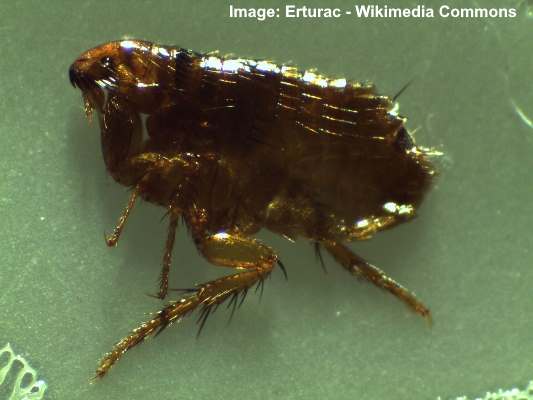
A close up picture of a flea (35x zoom optical microscope)
Fleas are small, wingless parasitic dark-colored insects resembling black poppy seeds. Although they look brown under a microscope, fleas commonly appear black to the naked eye. They have a flattened body shape and long hind legs they use to jump long distances. Fleas grow 0.12” (3 mm) long.
Fleas commonly infest cats, dogs, and other animals. The tiny seed-like creatures feed on the blood of their hosts, causing itchiness and discomfort. In addition to pets, fleas can bite humans, leaving behind itchy red bumps. You will usually find fleas in bedding, carpeting, and furniture.
Flea infestations are difficult to eliminate because the blackish-brown bugs are so tiny. Apart from the annoying, itchy bites, fleas also spread disease. Therefore, getting rid of fleas is crucial.
How to get rid of tiny black bugs
The CDC recommends treating pets regularly for fleas to prevent an infestation in your home. It’s also vital to thoroughly clean areas where fleas breed—bedding, rugs, and pet bedding. Also, vacuuming carpeted areas and along baseboards is crucial to eradicating the tiny bugs.
Ticks (Ixodida)
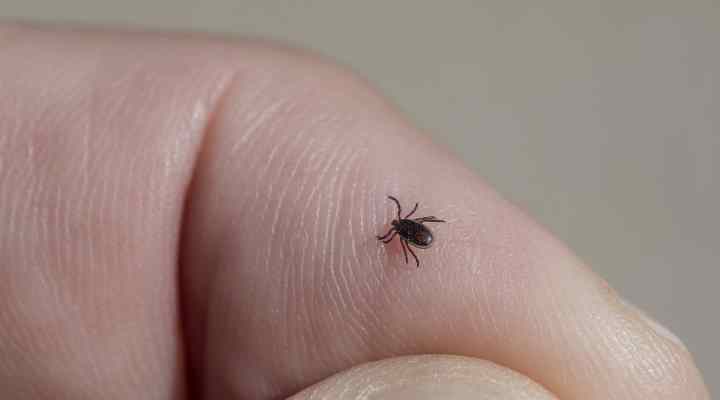
Tick nymphs are tiny black bugs that look like poppy seeds
Baby ticks, commonly known as nymph ticks, are small parasitic bugs resembling dark specks, similar to black poppy seeds. These tiny parasitic bugs, also called seed ticks, survive by feeding on the blood of animals and humans. They have a distinctive brown or black flattened, oval-shaped body with eight legs. Upon reaching adulthood, adult ticks grow to a length of 0.12” to 0.20” (3 – 5 mm).
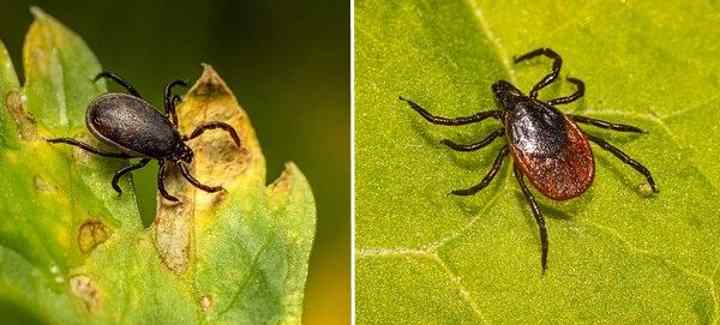
Adult black-legged male tick (left) is smaller and black, whereas the female (right) is black and brown
Ticks get into the home by attaching themselves to their host for extended periods. The disease-carrying bugs lurk in wooded areas, tall grasses, and shrubs. They latch onto their host (animals or humans) by burrowing their mouthparts into the skin and enjoying a blood meal where they become engorged.
Ticks transmit diseases like Lyme disease and Rocky Mountain spotted fever. Therefore, preventing ticks from getting on your skin when enjoying the outdoors is vital.
To identify ticks, look for a tiny black bug stuck to the skin resembling a tiny black seed or mole. They may also appear engorged after feeding.
How to get rid of tiny black bugs
It is important to remove ticks properly to avoid leaving any mouthparts behind, as this can increase the risk of infection. Doctors recommend tweezers to grasp the tick as close to the skin’s surface as possible. Then, gently lift the tick upward to remove it from your or your pet’s skin.
According to the CDC, you should see your doctor if you develop a rash or fever in the weeks following a tick bite.
Black Bean Aphid (Aphis fabae)
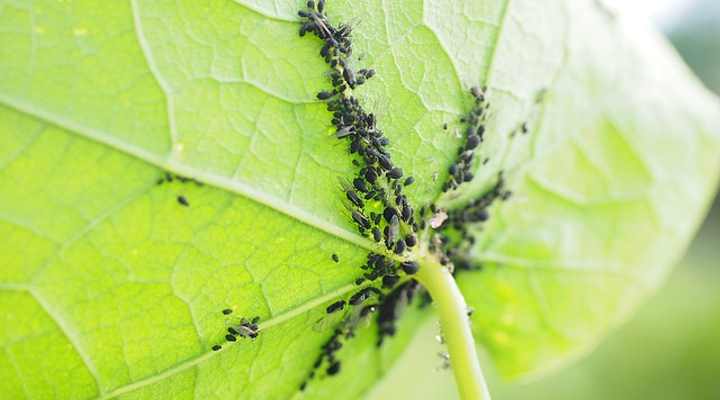
Black bean aphids on the underside of a leaf look like poppy seeds or black sesame seeds
Black aphids, measuring approximately 0.07 inches (2 mm) in length bear a striking resemblance to minuscule poppy seeds. Commonly known as blackflies, these small insects feature a black pear-shaped and plump body with a minute head and rounded abdomen. They have yellowish legs with black tips. Some black aphids also fly, meaning the bugs can infest houseplants and greenhouse crops.

A close up picture of black bean aphids and tiny aphid nymphs
The black bugs bite into plant tissue to suck the juices. A large black aphid infestation can weaken a plant’s health and eventually cause death. Additionally, the black plant-destroying bugs transmit plant diseases.
Signs of black bugs attacking plants are an amber-colored sticky substance called honeydew and black sooty molds on leaves and stems. You may also notice tiny black seed-like bugs under the plant’s leaves. Infested plants usually have wilting stems and slow growth.
How to get rid of tiny black bugs
To eliminate black bugs like aphids, create a neem oil bug spray. You can make the natural insecticide by adding 2 tsp. of organic neem oil to a quart (1 l) of water and a small amount of liquid soap in a spray bottle. Mix the solution thoroughly. Then spray liberally on plant foliage to kill the tiny speck-like black bugs.
Related reading: How to kill aphids naturally.
Elder Aphid (Aphis sambuci)
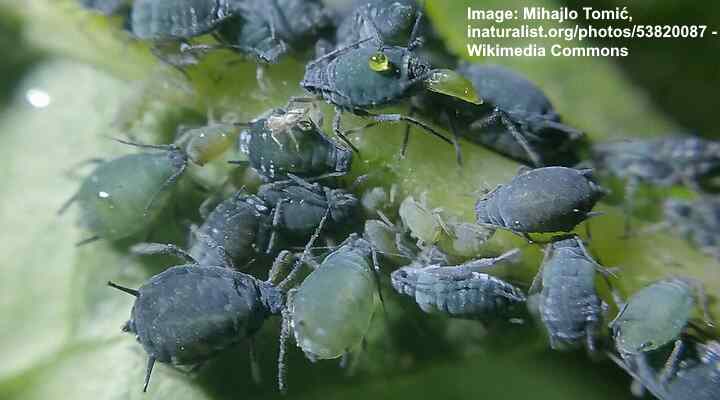
A close up picture of elder aphids and tiny aphid nymphs infesting a plant
Infestations of black elder aphids look like large clusters of poppy seeds on plant branches. The tiny black bugs are dark green to black, only measuring 0.07” to 0.13” (2 – 3.5 mm) long. The black-colored aphids have black legs and whitish bands on their abdominal segments.
However, the black bugs are just like dark specks. Therefore, they are so tiny you need a magnifying lens or microscope to see their identification characteristics. They are also difficult to differentiate from regular black aphids or blackfly.
Flea Beetles (Alticini)
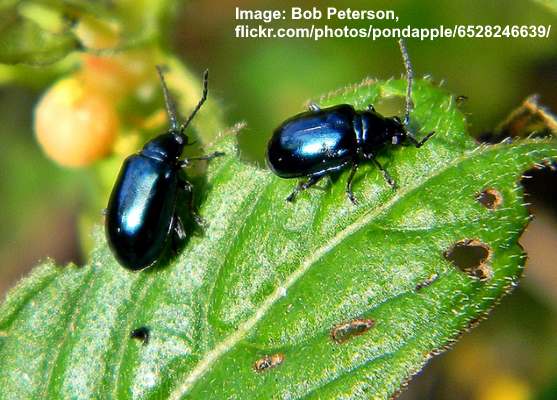
Metallic blue flea beetles (Alticini) chew on a leaf
Tiny black bugs that look like poppy seeds could be flea beetles. These hard-shelled black bugs are typically black with a metallic sheen on their bodies. A distinguishing feature of the beetles is their large, powerful hind legs that give them the ability to jump like fleas.
The black beetles have a narrow, elongated body measuring 0.1” (2.5 mm) in length. Many people classify black flea beetles as bugs because they attack many crop leaves, and their larvae chew on roots. Thankfully, the tiny black bugs tend to stay out of homes, preferring to feed on cruciferous plants.
Identifying flea beetles can be challenging because they look like tiny specks or poppy seeds. However, if you notice tiny seed-like black bugs jumping on plants, they will likely be flea beetles. Also, some flea beetles have black and white stripes, red heads, or brown bodies.
How to get rid of tiny black bugs
Diatomaceous earth (DE) is an effective, non-toxic solution to eliminate many types of tiny black bugs. Apply diatomaceous earth on dry ground around your ornamental plants and crops and sprinkle it on plant foliage. The abrasive substance destroys the beetle’s exoskeletons, causing them to dehydrate and die.
The DE must be replaced after rainfall and applied only to dry ground.
Additionally, you can control flea beetles naturally by introducing beneficial insects, such as ladybugs and lacewings, in greenhouses.
Black Mites (Acari)
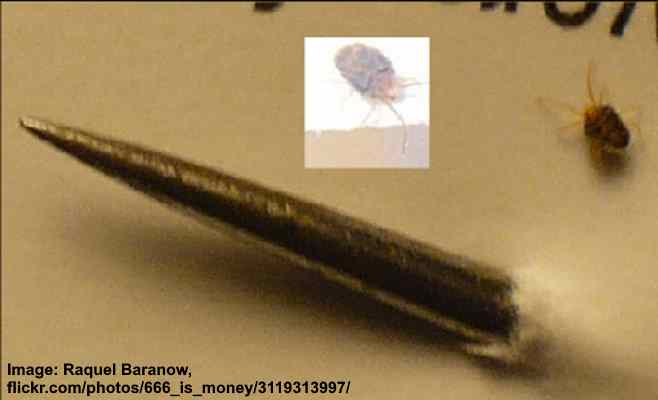
An image of a clover mite (Bryobia praetiosa) with sewing needle
Black mites can look like a dusting of black pepper. The tiny black bugs measure less than 0.04” (1 mm)—about the same size as poppy seeds. The identifying features of individual black mites are almost impossible to distinguish. However, some mites, like scabies and other black mites, colonize human skin and cause severe itching and red patches.
Clover mites (Bryobia praetiosa) are a type of oval-shaped dark red bug that appears black with the naked eye. They can enter the home through open windows and doors. These dark red-brown bugs are also types of pesky bugs that you can find on windowsills. Although they don’t bite humans, clover mites are a nuisance when large numbers infest homes.
How to get rid of tiny black bugs
If you have red clover mites inside your home, use a vacuum cleaner to eliminate them. This approach ensures you don’t crush the mites, which can lead to stains on your carpets, drapes, or upholstery. After vacuuming the red bugs, dispose of the dust bag in the outdoor trash.
To prevent tiny black bugs from infesting your home, create a 2 ft. (0.6 m) gap between your building and shrubs or grass.
Bed Bugs (Cimex)

Enlarged picture of a bed bug – The tiny brown bed bugs look black but are actually brown
Bed bugs are tiny dark brown, black-looking bugs that range in size from poppy seeds to apple seeds. The parasitic bugs have a flat, oval body and can grow 0.16” to 0.20” (4 – 5 mm). The nasty blood-sucking bugs swell and turn blackish-red after a blood meal.
Bed bug eggs, measuring around 0.04” (1 mm) in length, share a striking resemblance to tiny poppy seeds, albeit in a pearly-white color. These eggs appear as small clusters of white speckles or white sesame seeds attached to various surfaces, such as bed frames, the back of headboards, or baseboards.
How to get rid of tiny black bugs
Getting rid of bed bugs is challenging. It requires a combination of thorough cleaning and professional insecticide treatments. Additionally, you can steam-clean, soft furnishings and upholstery to kill the tiny black bugs and their eggs.
Black Spider Beetle (Mezium americanum)
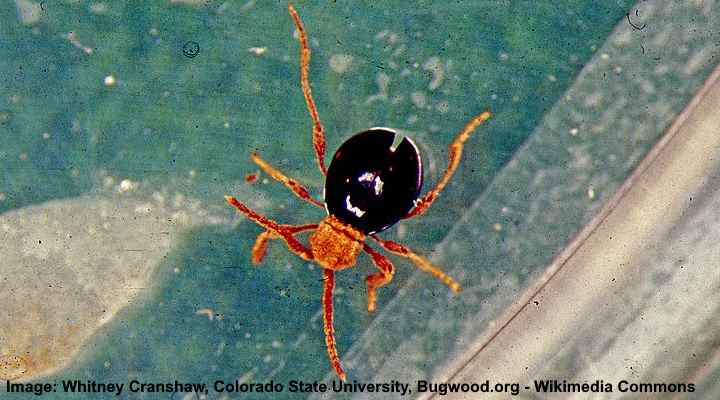
Black spider beetle (Mezium americanum)
Black spider beetle babies are easily mistaken for poppy seeds. The adult spider beetles have a dark reddish-brown to shiny black body. They have easily recognizable bright orange legs and an orange head. The tiny black beetles grow 0.06” to 0.14” (1.5 – 3.5 mm) long.
Also called the American spider beetle, the tiny black insects are called bugs because they infest seeds, dried fruits, cereals, herbs, and spices. This behavior makes the minuscule black bugs serious pantry pests.
How to get rid of tiny black bugs
To get rid of American spider beetles, remove infested items from your pantry. Next, vacuum all cracks and crevices to eliminate any eggs or tiny beetle babies. Then, store food in airtight jars or containers.
Black Gnats (Sciaridae)
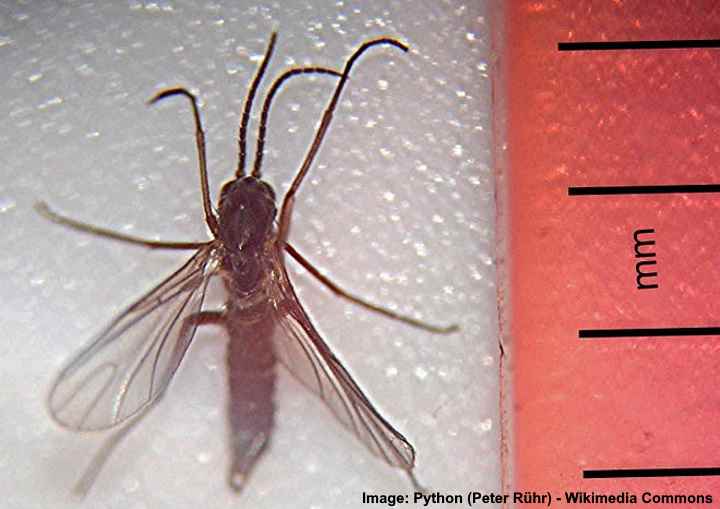
Gants are small black flying bugs that can be found in damp places in the house
Black gnats are tiny black flies that can be as small as black poppy seeds or as large as fruit flies. Growing between 0.04” and 0.43” (1 – 11 mm) long, fungus gnats are slender flying insects, typically with black or dark brown bodies. The dark-winged fungus gnats have black legs, a tiny head, and black wings.
These annoying flies typically live in the moist soil of houseplants. They are attracted to light and are often seen flying indoors near windows. Several dead black gnats can look like a scattering of poppy seeds on a windowsill. The tiny black flies don’t harm plants or bite humans.
How to get rid of tiny black bugs
It’s vital to reduce the moisture in the soil to get rid of fungus gnats for good. The best way to do this is by allowing the top layer of soil to dry out before watering your plants. Remove any decaying plant debris and dispose of it in a sealed bag.
You can also rinse the soil with a hydrogen peroxide solution. Mix one part hydrogen peroxide (3%) with four parts water and apply it to the soil to kill the gnats and their larvae.
Related reading: How to water houseplants.
Black Carpet Beetles (Attagenus unicolor)
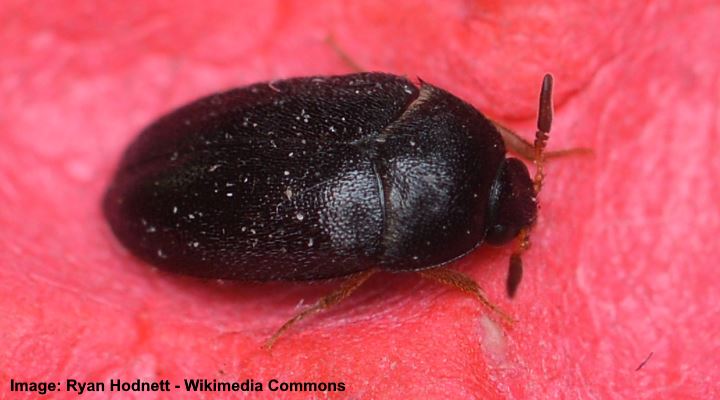
The black carpet beetle is a tiny seed-like bug that infests carpets and fabrics in the house
Black carpet beetles are small, oval-shaped bugs with shiny black or dark brown bodies. The small black bugs typically measure 0.13” to 0.19” (3 – 5 mm) long, making them about the size and shape of black sesame seeds. Black carpet beetle larvae are small, hairy, and carrot-shaped, ranging in color from light brown to black.
The larvae of black carpet beetles can do tremendous damage. They chew on fabrics and can be a nuisance in homes, feeding on various organic materials, including carpets, furniture, and clothing. Identifying black carpet beetles can help determine the most effective control measures to prevent infestations and further damage.
How to get rid of tiny black bugs
The best way to get rid of black carpet beetles for good is to keep fabrics in the home clean. For example, thoroughly laundering in hot water or dry cleaning clothes, blankets, and other washable items kills carpet beetles at all life cycle stages.
Black Weevils
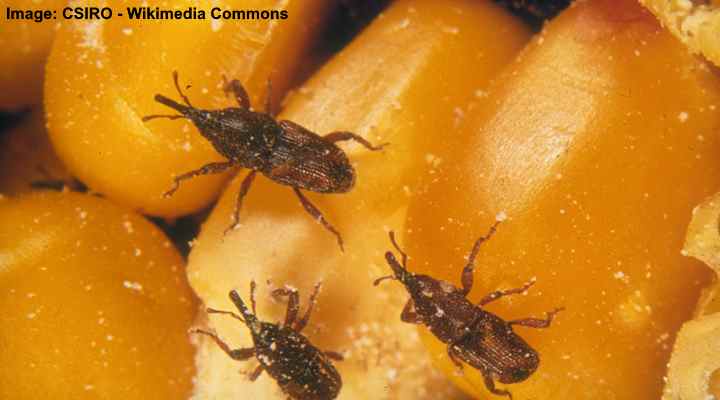
Rice weevils (Sitophilus oryzae)
Many black weevils are common tiny black or dark brown bugs resembling poppy seeds. Black weevils that invade homes are easy to identify. They are generally small, black or dark brown, with elongated snouts, pear-shaped bodies, and hard exoskeletons. The tiny black bugs enter homes through cracks in windows or doors.
Black weevils can be found in various habitats, including gardens, fields, and forests. They feed on various plants, including strawberries, trees, and shrubs. Many black weevils in the home are generally only nuisance bugs as they don’t bite or sting humans or spread disease.
How to get rid of tiny black bugs
One of the best ways to prevent black weevils from entering your home is to seal off any cracks and crevices around windows and doors. Some say chopping fresh bay leaves and placing them on pantry shelves helps repel these tiny black bugs in kitchens.
Black Pantry Bugs
Black pantry bugs are generally tiny beetles or weevils that look like dark brown or black poppy seeds. These pests get their name from their habit of infesting dry, stored foodstuffs. You can find them in packets of seeds, grains, cereals, flour, rice, pasta, and pet food.
Here is a list of common pantry bugs easily mistaken for black poppy or sesame seeds:
- Sawtoothed grain beetles (Oryzaephilus surinamensis)
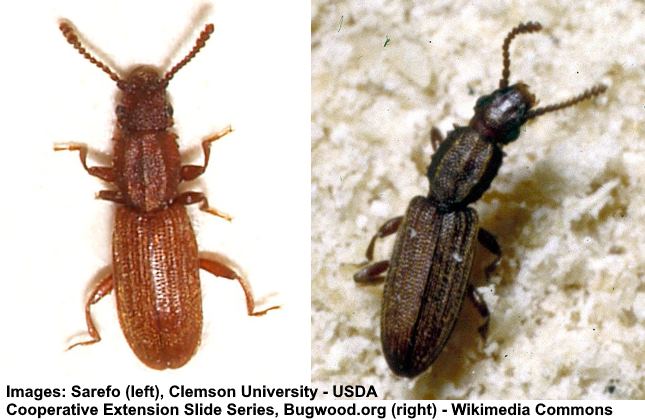
Sawtoothed grain beetles are tiny bugs in the pantry that range in color from rusty brown to dark brown
- Black spider beetles
- Rice weevil (Sitophilus oryzae)
- Drugstore Beetle (Stegobium paniceum)
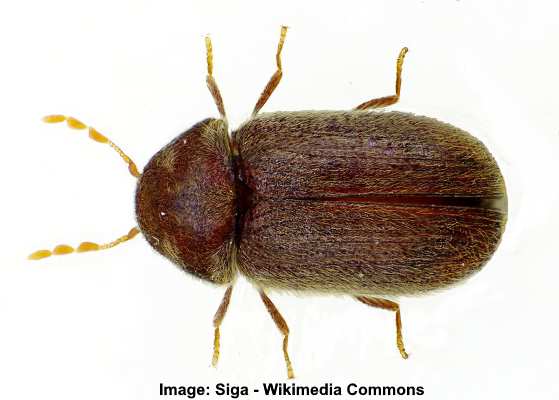
Drugstore Beetle (Stegobium paniceum)
- Flea beetles
- Black grain mites
How to get rid of tiny black bugs
The best way to get rid of pantry bugs is to detect and locate them early. Check your food items regularly for signs of infestation, such as small holes or webbing. Discard any items in a sealed plastic bag in the trash outside your home. Also, clean shelves, cracks, and crevices with a vacuum cleaner. Then wipe countertops and shelves with a cloth soaked in soapy water.
It’s also a good idea to store all food items, including pet food, in airtight containers or sealable plastic bags. You can also place dried foodstuffs in the freezer for four to five days to kill eggs, larvae, and bugs that may be in packaging.
Related articles:
